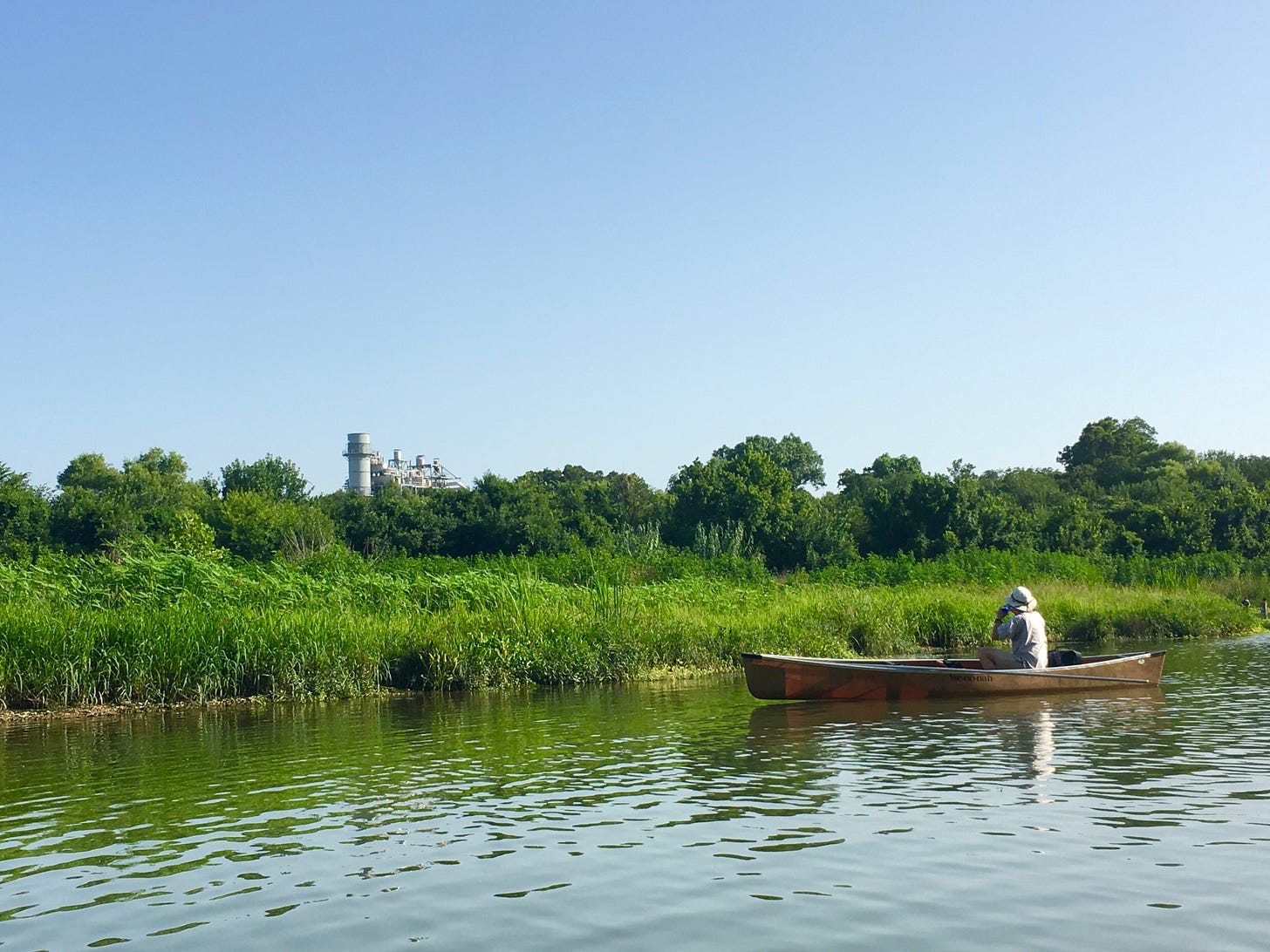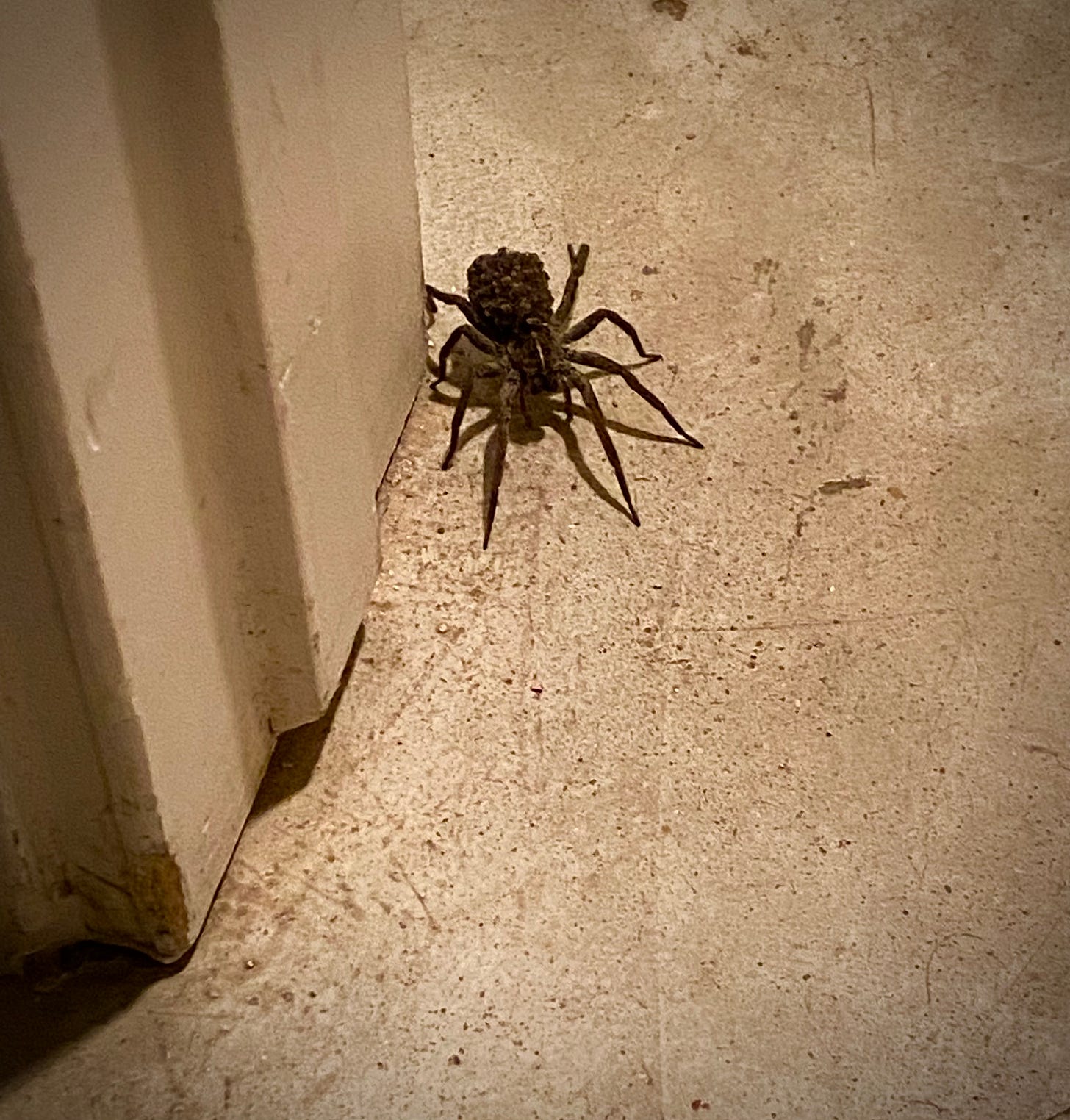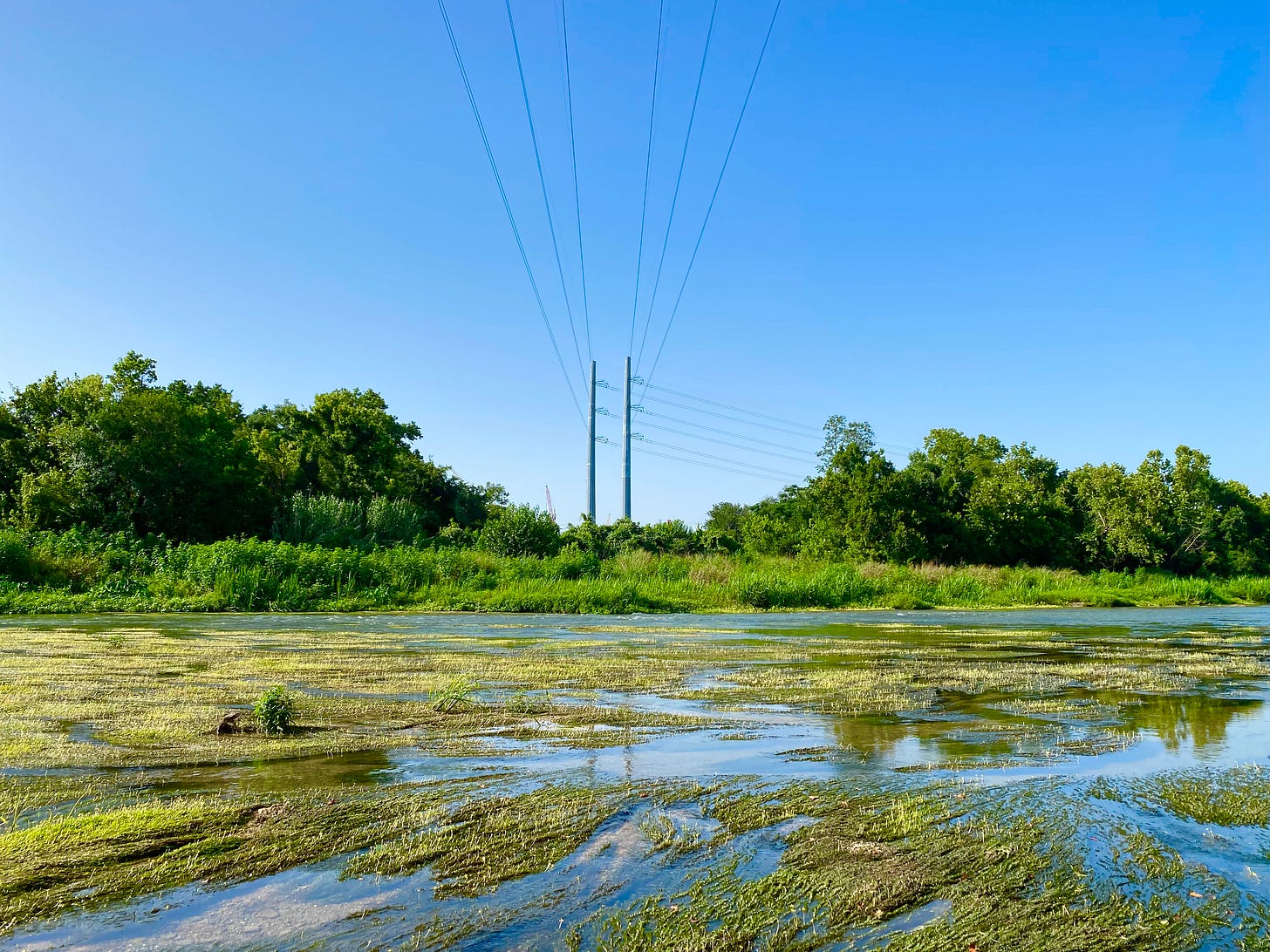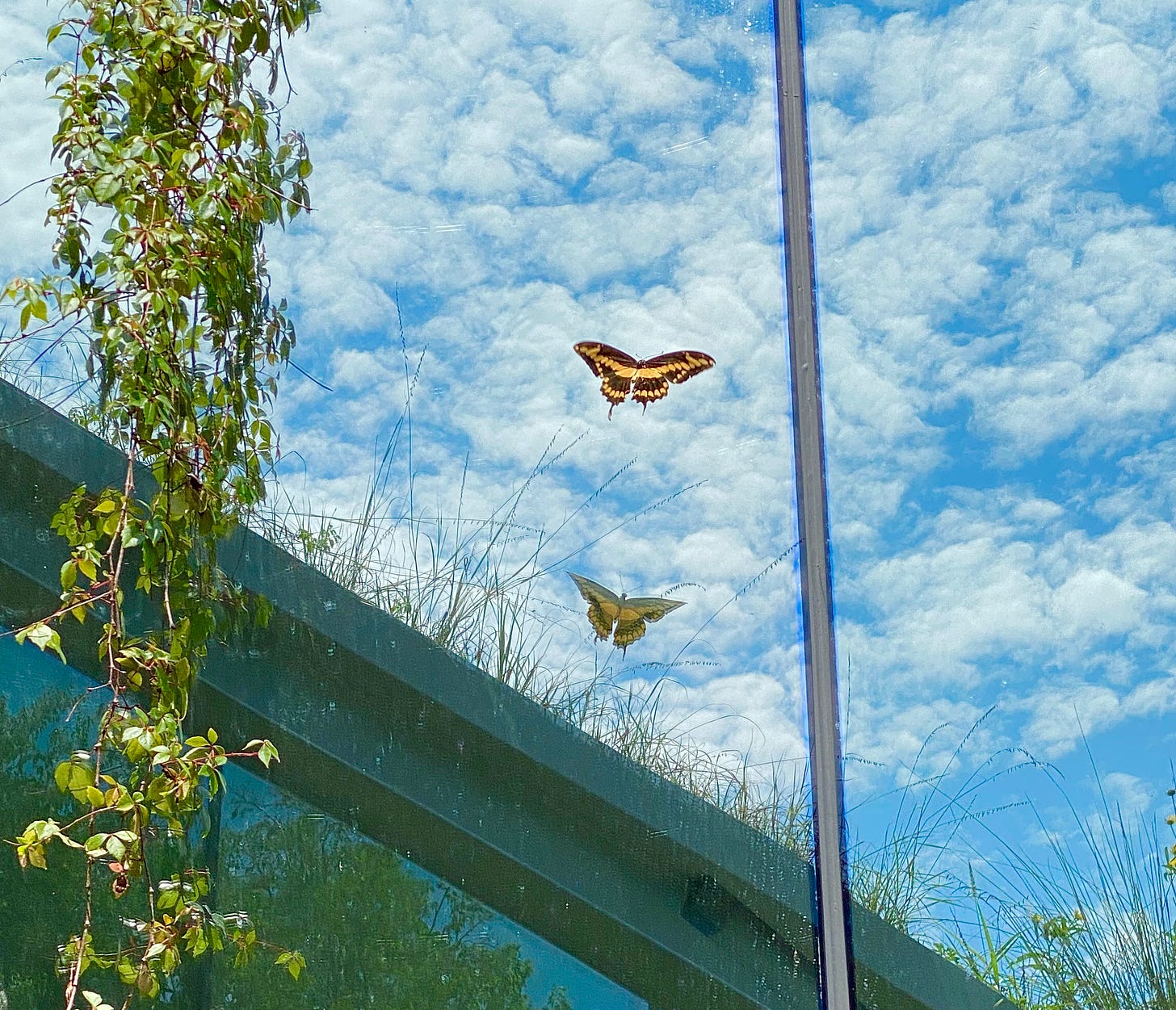Spider babies and Gigafactory futures
Monday morning before dawn this spider greeted me at the threshold of our kitchen bathroom, exposed on the floor as I reached in with the hand that wasn’t holding the coffee cup and turned on the light. We have a lot of spiders in our house, and you mostly get used to them. But this one looked different than the wolf spiders we typically see at that size. It froze long enough for me to take this picture, but then disappeared under the cabinet.
Wolf spiders are fearsome-looking—hairy, tiger striped, and often as big as your hand—but harmless to humans. And freakishly delicate, for their size, easily killed with a glancing touch even when you are trying not to injure them. Here’s one I found some years ago in one of the snake boots I had left outside, right after I pulled it out so I could put the boots on to head into the woods.
Living in a house that’s mostly buried underground, and with a pocket tallgrass prairie growing on your roof, you find yourselves sharing your home with a lot of weird insects. And the gnarliest ones are usually the ones that hide in the dark. The ones that like to hang out in the bathroom all night. I’ve never encountered a brown recluse here, and I don’t even know if I could reliably identify one if I did. But in the early years right after we built the place and moved in, black widows were pretty common. Here is one I found while rummaging in the utility closet:
Then there’s the one I found that had made a web along the side of the toilet, which I only noticed when I was sitting on it. Those pictures didn’t turn out as well.
It was only on Tuesday morning that I realized what exceptional spider habitat we had made of our guest bathroom. I found that same strange-looking spider from Monday just outside the bathroom door, and when it saw me it went toward the window. I opened the door to try to let it out, but it went the other way. So I grabbed a section of the morning paper and tried to guide it back to the open. That’s when I learned the strange little lumps all over its abdomen that had made it so hard to identify were its babies.
They scattered upon my intervention, half of them following mom outside and half scurrying across our concrete floor. A few stayed on their ride, and many climbed back up. There might have been a hundred, each smaller than a pinhead. Confirming better than any of the usual markings that this was a wolf spider:
Wolf spiders are unique in the way that they carry their eggs. The egg sac, a round, silken globe, is attached to the spinnerets at the end of the abdomen, allowing the spider to carry her unhatched young with her. The abdomen must be held in a raised position to keep the egg case from dragging on the ground. Despite this handicap, they are still capable of hunting. Another aspect unique to wolf spiders is their method of care of young. Immediately after the spiderlings emerge from their protective silken case, they clamber up their mother's legs and crowd onto the dorsal side of her abdomen. The mother carries the spiderlings for several weeks before they are large enough to disperse and fend for themselves. No other spiders are currently known to carry their young on their backs for any period of time.
We had an amazing virtual kickoff meeting Saturday of the new Colorado River Conservancy I have been working on with my friends from the environmental justice group PODER. The turnout was amazing, with a diverse array of folks who share a love of the wild and scenic urban river we are lucky to have flowing here from the eastern edge of town below the last dam between here and the Gulf. It was amazing to hear the stories people shared of their different connections to the river, and heartening to find so many folks who share our desire to protect it. Especially as we heard stories of the many threats facing the river that people see from those diverse vantage points. Please join our mailing list if you’re interested in hearing more, especially if you’re in Central Texas.
Saturday evening one of the other attendees at that meeting and I went down to try to check out one of those threats, by paddling the stretch of river that flows past the site of the new Tesla Gigafactory just outside of the Austin city limits. We met at the end of the day in the shade of a small bridge, one of those places where people park to party in and along the water on hot summer days. Loose dogs, happy kids, cold beer, and music bouncing off the concrete. One guy had a good-sized pig roasting on a spit he was slowly turning over a pile of coals at the water’s edge. My companion told me of some of the antiquities he has found at that site, and the scene helped to unmoor us from time.
It was as hot as it’s been all summer when we put in, with a good flow and the river flush with the bright green palette of aquatic vegetation. Green herons were working the side channels as we looked for signs of endangered mussels and found plenty of discarded shells along a spot where a spring seeps from the bank opposite the Tesla site. The only sign of what’s coming behind the trees was the large number of brand new power lines headed in the direction of the plant, so many coming from so many directions that it made you consider just how much energy it must take to run a “Gigafactory.”
The zone we traveled through is one that was heavily mined by aggregate companies in the century passed. The Tesla site was a huge operation most recently owned and operated by the defense contractor Martin-Marietta, using permits that date back to the 70s and run with the land. It made one wonder what environmental sins of the past might be benefitting the new operation, and whether there is any real oversight of what’s going on there.

Further down, we entered an area bathed in a weird noise so loud it almost drowned out the chattering skeows of the green herons. A roar of burning wind, like the sound of Vulcan’s blowtorch. You could just see the source beyond the rushes, over the treeline—a newer power plant from which some of those distribution lines come.
We paddled on farther than we planned, around a big bend until we found a spot where one of the work roads around the plant comes right up to the water. It might even be a public road, judging from the maps. We pulled up our boats and clambered up the bank to see what we could see from the gradient bound. It was a spot to be revisited.
The paddle back against the current was hard work, even as the sun had begun to work its way down toward the western horizon. The dudes who had been out there at the beginning of our trip, net fishing in the shallows, looked at us like we were crazy, and they were probably right. We had been out long enough that the pig was off the spit when we took out, and the energy under the bridge a little more lubricated.
Toward the end of that paddle, we finally found one vantage where you could see the new factory from the river. Just a sliver of the roofline, below the cranes, there at the spot where the power lines intersect. We were talking about some of the crazier stories compiled in Indian Depredations in Texas, written by one of the first Anglo-Americans to settle the area around that site, chronicling the violent conflicts between those first-generation ranchers and the peoples whose artifacts one can still find along the river. A book that valorizes the settlers and demonizes the people they mostly erased, but still provides a critical reader tremendous insight into that history. It wasn’t until I got home that I got to thinking about the straight line between those stories and the future history we had seen unfolding.
The techno-baron whose personality is what really powers the construction of that new castle of capital is talking about building a SpaceX facility on the opposite side of the road under which we parked, outpost of a new branch of the colonization project that had been in the news a few days earlier. As I went through my photos from the week and saw that full moon from Friday night, I wondered what guys like Bezos and Musk would do if they really could plant their flags on other worlds where they really could make up their own rules. But then I realized that’s what we already let them do here. And that as much as I love imagining popular uprisings that alter the balance of power, nature is the force that’s most likely to check the hubris of men who presume to think they could own the stars. And it operates on a different clock.
Notes from other zones
I read an interesting piece at Calvert Journal this week about the phenomenon of Chernobyl tourism, and the subculture of real-world stalkers who guide people on illegal visits into the unsafe parts of the exclusion zone, consciously riffing on the fictional guides of the Strugatsky brothers’ Roadside Picnic and Tarkovsky’s Stalker.
The Yale School of the Environment has an excellent new piece up at their site on the counterintuitive revelation I discuss here often: that cities can foster biodiversity, especially if we design and build them in a way that consciously encourages other species to share our habitat. It’s an important piece, and worth reading alone for the concise compendium of remarkable animal adaptations it provides, illustrated with some incredible photos.
Over at MIT Press, a great short essay by Sherryl Vint on the ways the science fiction of the past century has helped shape and reshape the ways we think about our real-world environment.
And the new issue of Texas Monthly that arrived in yesterday’s mail has a nice long profile of Field Notes friend and Austin visionary Liz Lambert (described in the piece as “a mythic hard-charging West Texas lesbian pro-growth lib-backing motorcycle-riding unbounded dreamer”). It’s a great business story, and an illuminating profile of how a driven polymath can bring her diverse skills and ideas together to realize a vision that reshapes the world around her in a positive way. If creative entrepreneurs like Liz were the ones imagining our future life on Mars, I might even be able to get with the program.
Lastly, if you want to see the Tesla site around which we paddled, you can see it under construction here, or in the drone videos of the fanboys who monitor the project from more sensible locations. Here’s one who was out there when we were:
Have a great week.











Terrific post!
They are so informative.
Terrific images.
Thanks.
That's fascinating about the wolf spiders carrying their babies; I had no idea. And you got a great photo to illustrate it.